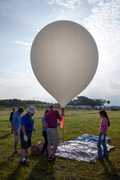
Synergistic TEMPO Air Quality Science
Atmospheric Composition
- 1
- view all deployment datesDeployment
2023-06-24 2023-08-28 - 7
- Platforms
- 11
- Data Products
The Campaign
The Synergistic TEMPO Air Quality Science (STAQS) was a NASA field investigation aimed at improving understanding of air quality science for societal benefits by combining TEMPO satellite observations with airborne and ground-based air quality measurements. STAQS collected data over cities like Los Angeles, New York City, and Chicago during the summer of 2023. NASA G-V and G-III aircraft were equipped with remote sensing sensors such as GEOstationary Coastal and Air Pollution Events (GEO-CAPE) Airborne Simulator (GCAS), Airborne Visible InfraRed Imaging Spectrometer - Next Generation (AVIRIS-NG), and High Altitude Lidar Observatory (HALO) to measure aerosols and greenhouse gases. These measurements were complemented by ground-based observations from TOLNet and Pandora. STAQS was funded through the NASA Tropospheric Composition Program.
N: 46°N
S: 28°N
W: 120°W
E: 71°W
no campaign DOI available
- ASDC Landing Page for STAQS
- STAQS Project Website (ESPO)
Additional Notes
STAQS collaborated with NOAA's Atmospheric Emissions and Reactions Observed from Megacities to Marine Areas (AEROMMA) and Coastal Urban Plume Dynamics Study (CUPiDS) investigations as well as NSF's Greater New York Oxidant Trace gas Halogen and Aerosol Airborne Mission (GOTHAAM).
Repositories

Field Site

Uncrewed Aerial Vehicle

Gulfstream III

Gulfstream-V

Permanent Land Site

Balloon Launch Site
Progressive Aerodyne SeaRey
Events
Filter data products from this campaign by specific platforms, instruments, or formats.
